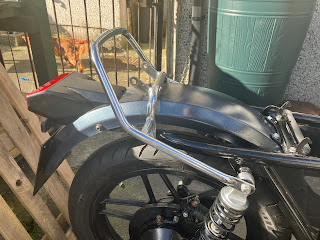Sunday, 2 March 2025
Big reassembly!
Friday, 24 January 2025
The Handlebar Conundrum
When I bought the pile of Guzzi bits that is slowly morphing into a real motorbike, the original handlebars weren't with the pile, but the seller gave me a choice of a couple of pairs of Renthal bars that he had.
The pile of parts has been moved twice since then and is now in my permanent house in Anglesey. I love my house but it has just one downside. Access to the back of the house is via a passageway between my house and the neighbours. The passageway itself is vey narrow, but there is a particular bottleneck at the front gate. This makes it very difficult to get bikes in and out, which is great from a security aspect, but a right pain in the arse in every other respect.
My Royal Enfield Classic 350 was way too wide in the handlebar region to get through and I ended up selling it, as I couldn't find any sensible way to adapt it by replacing handlebars etc. After much research about what to replace it with, I spotted that the Kawasaki GPZ 500 was about the narrowest middlesized bike that I could find and bought one of those. That will indeed go down - just - but only after I have folded in the mirrors and removed the bar ends!
When I bought the Enfield Crusader here, I only managed to get that through by 2 of us manhandling it, with the handlebars at a 45 degree angle and the front wheel on a platform with casters! I have been able to cut about 1.5" off each side of the handlebars on that and it will now go through - just, again - but that was only possible because it's an old bike, so doesn't need as much space at the end of the bars for things like brake master cylinders and big control/switch blocks.
So I've been agonising over what I'm going to do with the Guzzi, as the Renthal bars are way too wide, even after I've cut them down to the minimum amount of space I need to fit everything on, and any other bars I can find that are narrow enough don't have sufficient space for levers etc.
Irresistible mock up!
Brakes
Rear mudguard
Recovering seat
First things first I glued the front of the cover to the base, using UniBond contact adhesive. This meant that I could refit the rubber seat buffers on top of the vinyl, but still get access to the underside to pull the rubber lugs through that hold them in place.















.jpg)





























